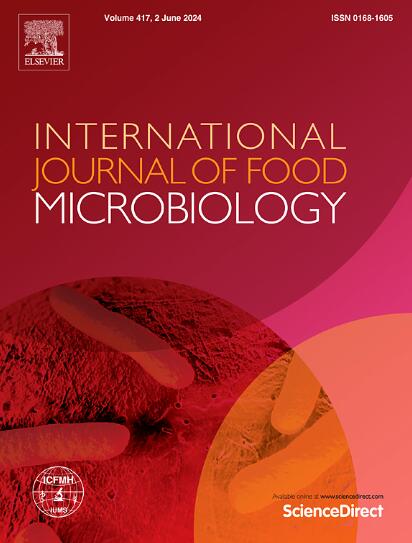Campylobacter in the domestic kitchen: Linking human and microbiological behaviour
IF 5
1区 农林科学
Q1 FOOD SCIENCE & TECHNOLOGY
International journal of food microbiology
Pub Date : 2025-05-15
DOI:10.1016/j.ijfoodmicro.2025.111270
引用次数: 0
Abstract
Campylobacter is a major cause of foodborne illness worldwide, and poultry products are considered as the main source of campylobacteriosis. This study provides insight into the hygienic practices of handling raw chicken at home in the Netherlands and quantifies the impact of these practices on the incidence of campylobacteriosis in a quantitative microbiological risk assessment (QMRA), with a specific focus on the number of illness cases rather than the risk per serving. A survey was conducted among Dutch consumers (n = 1974) to assess their raw chicken handling practices. The results showed that 95 % of consumers reported always or often thoroughly cooking chicken, indicating high compliance with safe practices. However, less safe practices were also reported, such as washing chicken before preparation (36 %) or replacing dishcloths once a week or less (23 %). Demographic analyses showed that females followed safe food-handling practices better than males, and respondents from households with children or with pregnant household members adhered better to safe practices than households without these characteristics. Quantitative experiments were conducted to measure the cross-contamination and transfer rate of Campylobacter jejuni from raw chicken fillet to cucumber. Replacing the cutting board resulted in a 75 % decrease in the transfer rate, while replacing the knife led to a 57 % reduction, both compared to the worst-case scenario of no replacement of cutleries. The QMRA predicted that the primary factor contributing to the risk of campylobacteriosis was the initial concentration. Scenario analysis highlighted thorough cooking as the most impactful intervention at home for reducing Campylobacter infection, followed by hand washing after handling raw chicken meat and replacing cutting boards. Sustained efforts to lower initial contamination levels, combined with targeted communication and improved consumer practices on hygienic measures, can effectively reduce the incidence and public health impact of foodborne illnesses associated with chicken consumption.
家庭厨房中的弯曲杆菌:将人类和微生物行为联系起来
弯曲杆菌是世界范围内食源性疾病的主要原因,家禽产品被认为是弯曲杆菌病的主要来源。本研究深入了解了荷兰家庭处理生鸡肉的卫生做法,并在定量微生物风险评估(QMRA)中量化了这些做法对弯曲杆菌病发病率的影响,特别关注疾病病例的数量,而不是每份风险。在荷兰消费者(n = 1974)中进行了一项调查,以评估他们处理生鸡肉的做法。结果显示,95%的消费者报告总是或经常彻底煮熟鸡肉,表明高度遵守安全做法。然而,也报告了不太安全的做法,例如在制备前清洗鸡肉(36%)或每周更换一次或更少的洗碗布(23%)。人口统计分析表明,女性比男性更好地遵循安全食品处理做法,来自有儿童或有怀孕家庭成员的家庭的受访者比没有这些特征的家庭更遵守安全做法。采用定量实验方法测定了生鸡块对黄瓜空肠弯曲菌的交叉污染和传递率。与不更换餐具的最坏情况相比,更换砧板导致传递率降低75%,而更换刀具导致传递率降低57%。QMRA预测,导致弯曲杆菌病风险的主要因素是初始浓度。情景分析强调,彻底烹饪是减少弯曲杆菌感染的最有效的家庭干预措施,其次是处理生鸡肉后洗手和更换砧板。持续努力降低最初的污染水平,结合有针对性的沟通和改进消费者卫生措施的做法,可以有效减少与食用鸡肉有关的食源性疾病的发病率和对公共卫生的影响。
本文章由计算机程序翻译,如有差异,请以英文原文为准。
求助全文
约1分钟内获得全文
求助全文
来源期刊
CiteScore
10.40
自引率
5.60%
发文量
322
审稿时长
65 days
期刊介绍:
The International Journal of Food Microbiology publishes papers dealing with all aspects of food microbiology. Articles must present information that is novel, has high impact and interest, and is of high scientific quality. They should provide scientific or technological advancement in the specific field of interest of the journal and enhance its strong international reputation. Preliminary or confirmatory results as well as contributions not strictly related to food microbiology will not be considered for publication.

 求助内容:
求助内容: 应助结果提醒方式:
应助结果提醒方式:


